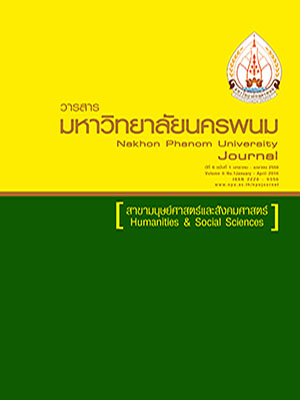รูปแบบความสัมพันธ์โครงสร้างเชิงเส้นของทีมคุณภาพที่ส่งผลต่อประสิทธิผลโรงเรียนประถมศึกษา ในภาคตะวันออกเฉียงเหนือ สังกัดสำนักงานคณะกรรมการการศึกษาขั้นพื้นฐาน
Main Article Content
Abstract
การวิจัยครั้งนี้มีวัตถุประสงค์เพื่อ 1) สร้างและตรวจสอบรูปแบบความสัมพันธ์โครงสร้างเชิงเส้นของทีมคุณภาพที่ส่งผลต่อประสิทธิผลโรงเรียนประถมศึกษา ในภาคตะวันออกเฉียงเหนือ สังกัดสำ นักงานคณะกรรมการการศึกษาขั้นพื้นฐานกับข้อมูลเชิงประจักษ์ และ 2) ศึกษาอิทธิพลทางตรง อิทธิพลทางอ้อมและอิทธิพลรวม ของทีมคุณภาพที่ส่งผลต่อประสิทธิผลโรงเรียนประถมศึกษาในภาคตะวันออกเฉียงเหนือ สังกัดสำนักงานคณะกรรมการการศึกษาขั้นพื้นฐาน ใช้ระเบียบวิธีวิจัยแบบผสานวิธี (Mixed Methods Research) แบ่งการวิจัยออกเป็น 2 ระยะ ได้แก่ ระยะที่ 1 สร้างกรอบแนวคิดการวิจัย และระยะที่ 2 ตรวจสอบสมมติฐานการวิจัยประชากรในการวิจัย คือ โรงเรียนประถมศึกษาในภาคตะวันออกเฉียงเหนือ ปีการศึกษา 2557 จำนวน 12,524 โรงเรียน กลุ่มตัวอย่าง คือ โรงเรียนประถมศึกษาในภาคตะวันออกเฉียงเหนือ ปีการศึกษา 2557 จำนวน 330 โรงเรียน ได้มาโดยการสุ่มแบบหลายขั้นตอนผู้ให้ข้อมูลคือ ผู้บริหารสถานศึกษา หัวหน้ากลุ่มสาระการเรียนรู้ และครูผู้สอน โรงเรียนละ 3 คน รวม 990 คน ผลการวิจัยพบว่า 1) รูปแบบที่สร้างขึ้น ประกอบด้วย บริบทขององค์การ ลักษณะของงาน คุณลักษณะของทีม กระบวนการทำงาน ของทีม และประสิทธิผลโรงเรียน 2) รูปแบบที่สร้างขึ้นมีความสอดคล้องกับข้อมูลเชิงประจักษ์ (χ2 = 38.34, P-value = 1, df = 141, RMSEA = 0.00, GFI = 0.99, AGFI = 0.97, LSR = 1.66) องค์ประกอบที่ส่งผลต่อประสิทธิผลโรงเรียนประถมศึกษามากที่สุดเป็นดังนี้ อิทธิพลทางตรง ได้แก่ กระบวนการทำงานของทีม อิทธิพลทางอ้อม ได้แก่ บริบทขององค์การ และอิทธิพลรวม ได้แก่ คุณลักษณะของทีมและลักษณะของงาน โดยองค์ประกอบทั้ง 4 องค์ประกอบดังกล่าวข้างต้น สามารถอธิบายทีมคุณภาพที่ส่งผลต่อประสิทธิผลของโรงเรียนประถมศึกษา ได้ร้อยละ 88
This study aimed : 1) to create a linear structural relationship model of quality teams affecting primary school effectiveness in the northeast under the office of the basic education commission, and 2) to investigate goodness of fit of the created model and the empirical data. The study was conducted in two phases : Phase I – determining a research conceptual framework and Phase II – testing the research hypotheses. Population in the study was 12,524 primary school administrators in the Northeast under the office of the Basic Education Commission. The sample were 330 schools in 2014 academic in the northeast under the office of the basic education commission, which were selected by multi-stage random sampling. The subjects were 990 persons who were the director, master teacher and teacher in the school. The findings were as follows : 1) The linear structural relationship model comprised of five components; organizational context, task characteristics, team characteristics, team process and school’s effectiveness. 2) The goodness of fit between the created model and the empirical data showed that they were a good fit (χ2 = 38.34, P-value = 1, df = 141, RMSEA = 0.00, GFI = 0.99, AGFI = 0.97,LSR = 1.66). The factors most impacting on the schools effectiveness ; direct influencers was team process, indirect factors was organizational context and factors which created total effects was team characteristic and task characteristic. When considering the prediction power, the four causal factors could explain the variance of with the value of school effectiveness 88 percent.


